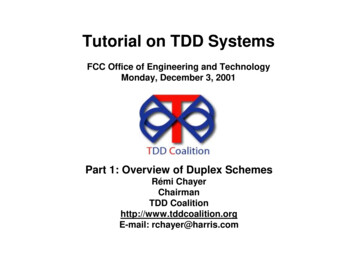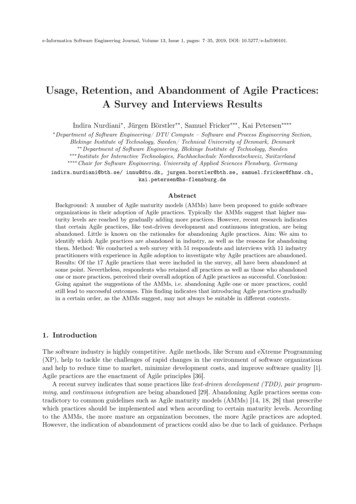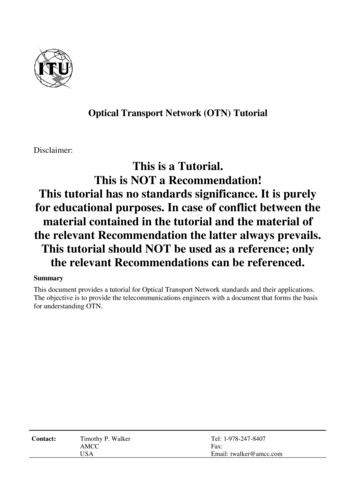
Transcription
Tutorial on TDD SystemsFCC Office of Engineering and TechnologyMonday, December 3, 2001Part 1: Overview of Duplex SchemesRémi ChayerChairmanTDD Coalitionhttp://www.tddcoalition.orgE-mail: rchayer@harris.com
The TDD CoalitionIt is the position of the TDD Coalition that with proper planning andregulatory considerations, TDD and other duplexing technologies cancoexist in the same geographic and spectral spaceAperto NetworksLinkAirArraycommMalibu NetworksBeamReach NetworksNavini NetworksCaly NetworksPointred TechnologiesClearwire TechnologiesRadiant NetworksHarris CorporationRaze TechnologiesInterDigitalWavion LtdIP WirelessDecember 3, 20012
Overview of the Duplex Schemes!Definitions"""!FDDTDDAdaptive TDDComparison of TDD vs FDD""""""Spectrum EfficiencySpectrum Allocation and UtilizationDeployment and Network Planning IssuesCompatibility with emerging applications and all-IP networks withasymmetric trafficAdaptability to advanced signal processing (adaptive antennas,user terminal beam-forming, etc.)Field trialsDecember 3, 20013
FDD – Frequency Division Duplexing!Separate in frequency the downstream and upstreamdirections of the traffic!Ratio between downstream and upstream traffic fixedby equipment design""!1/2 - 1/2 for voice2/3 – 1/3 for data (typical for 16QAM down, 4QAM up)FDD requires a guard band between the downstreamand upstreamUpstreamDecember 3, 2001FrequencySeparation: x MHzGuardBand4Downstream
TDD – Time Division Duplexing!Separate in time the downstream and upstreamdirections of the trafficAn example of TDD is half-duplex transmission on an HFcommunication system using a push-to-talk switch!Use a single frequency for both downstream andupstream!Ratio between downstream and upstream traffic canbe fixed or adaptive!TDD requires a guard time between the downstreamand upstream but no guard bandDecember 3, 20015
Data Traffic Asymmetrybutbutasymmetricovershorter intervalsInbound & Outbound Traffic (bps)100 secs duration, 1 sec bins2.0E 06Bits Per SecLBLLBL traffictraffic isis nearlynearlysymmetricsymmetricaveragedaveraged overover 22hourshours (53/47)(53/47)1.5E 061.0E 065.0E 050.0E 001000101010201030104010501060Time (sec)StatisticsStatistics AveragedAveraged OverOver 22 HourHour Trace:Trace:Aggregate:Aggregate: 392392 kbpskbpsInbound:Inbound: 185185 kbpskbpsOutbound:Outbound: 207207 kbpskbpsDecember 3, 200161070108010901100
Real-Time Adaptive TDD!Real-time adaptation provides highest transportefficiency""!TDD enables 100% use of available spectrum"!Millisecond real-time adaptation35% improvement over FDD/TDMAWell-suited for wide, single block allocations and narrow, dualblock allocationsMinimal latency variation enables prioritization ofpreferred subscribers and critical applicationsDecember 3, 20017
Spectral EfficiencyPercent Improvment in Spectral 56789Ratio 1:X of Traffic LoadWith asymmetric traffic (data), TDD systems use spectrum moreefficiently than FDD systems.December 3, 2001810
Spectral Efficiency!Minimize guard band!Change symmetry on the fly depending onsubscriber’s needs!Adaptive downstream/upstream ratio allows foremerging new applications without the need forspectrum re-farming!Enables advanced technologies such as meshnetwork and adaptive antenna arrays!Highly effective for bursty data traffic while stillsupporting voiceDecember 3, 20019
Spectrum Allocation and Utilization!TDD allowed by the FCC, CEPT, Japan, Canada andmany other countries!Some countries still need to be convinced!FDD absolutely requires paired spectrum!TDD can be used with paired and unpaired spectrum“TDD can use either sub-band and the middle guard band”(from an ITU-R Recommendation)!Block edge mask contributes to TDD/FDDcoexistence!New mitigation techniques are being developed(Autonomous Frequency Allocation – AFA for example)December 3, 200110
A Proven Technique!Used successfully since many years with DECT andPHS!Successfully deployed in recent UTRA-TDD multi-sitefield trial!Supported by the recently released IEEE 802.16standard and by the developing IEEE 802.16a!Multiple studies demonstrated coexistence feasibility(IEEE 802.16.2 and CEPT reports)December 3, 200111
Tutorial on TDD SystemsFCC Office of Engineering and TechnologyMonday, December 3, 2001Part 2: Worldwide TDD DeploymentsDr. Manouchehr RafieCALY om
Outline!TDD - Worldwide!TDD - Motivation!Mobile Wireless""!Fixed Wireless""!Cordless3GWMANWLAN / WPANEmerging TechnologiesDecember 3, 200114
TDD is widely used!TDD is used in ETSI standards, IEEE standards,MMAC, and in many proprietary systems!There are many compelling reasons for this choicenetreIntncyeiicEffet imengacSp cessiproPDSrediapUn ctrumeSpDecember 3, 2001ivetpaAd DDTtcke saP icevsershMelink gnwDo essincPr ostoCtryemymsAerwPo trolcon15calorcip neleR hanCay grrA ssinceprolerpSi m
TDD Advantages – MOTIVATION!!Flexibility with traffic asymmetry!Efficiency / cost / simplicity!Dynamic resource allocations!Channel reciprocity!Innovations and signal processing"""""!Dynamic topology – MESH"!Time-space processingDownlink processingSmart antennaPower control managementAdaptive modulation / frame boundarySelf-organizing networkInternet servicesDecember 3, 200116
Worldwide TDD Deployments!Mobile environment""""!Fixed environment - WMAN"""!DECT (Digital Enhanced Cordless Telecommunications – Europe)CT2 (cordless Telephone)PHS (Personal Handyphone System – Japan)3GPP: UTRA-TDD modeIEEE802.16 (PMP systems in 10-66 GHz range)IEEE802.16ab (systems in 2-11 GHz range)HIPERACCESS (PMP systems – Europe)Fixed environment – WLAN / WPAN"""""IEEE802.11 (USA)HIPERLAN (Europe)MMACBluetoothHome RFDecember 3, 200117
TDD – Digital Cordless TelephonesDig ital Co rdle s s Te le pho ne sCT2/ CT2 DECTP HSCo rdle s s Te le pho ne 2Digita l Enha nc e dCo rdle s s Te le pho neP e rs o na l Ha ndyP ho ne S ys te mMo bile FrequencyCT2: 864/8681880-19001895-1918Range (MHz)CT2 : 944/948Multiple Acces sTDMA/FDMTDMA/FDMTDMA/FDMDuplex Metho dTDDTDDTDDNumber of Channels4010300(12 us ers /chanel)(4 us ers /channel)300 kHzS ta nda rdMetho dChannel Spacing100 kHz1.728 MHzModulatio nGFSKGFSK(0.5 Gaus s ian Filter)(0.5 Gaus s ian Filter)72 kb/s1.152 Mb/sChannel Bit RateDecember 3, 200118π/4 DQP SK384 kb/s
DECT/PHS!TDD and TDMA!Efficient use of spectrumand high user density!Voice and data services supported""""!DECT GAPDPRS (up to 552kbit/s)DECT 2Mbit/sIMT2000 migration pathMiniaturization""Small, light, low cost devices are feasiblePHS has been used for animal trackingDecember 3, 200119
IMT-2000 Modes 3GPP members: ETSI (Eu) T1 (US) ARIB and TTC (Japan) CWTS (China)December 3, 2001 TTA (S. Korea)20
UTRA - TDD Accepted IMT-2000 Standard (ITU-TC), meets ITU requirements for 3Gdata speeds – 3GPP TDD systems benefits: Downlink processing, smart antenna, space-time processing, Technology consists of W-CDMA air interface coupled with GSMcompatible core network to allow equipment sharing with GSM/GPRS andUTRA-FDD networks Standard chip rate of 3.84 Mcps, 2X chip rate in future standard release Standard channel BW of 5 MHz is compatible with 6 MHz MMDS chann. Frequency allocation for UTRA-TDD: 1900 – 1920 MHz, 2010 – 2025 MHzin Europe WRC2000 allocated an IMT-2000 expansion band from 2500 – 2690 MHz,TDD allocation being considered across Europe for this bandDecember 3, 200121
Frequencies – Fixed WirelessDecember 3, 200122
Frequencies – Fixed WirelessDecember 3, 200123
FBWA - IEEE802.16!Air interface (PHYs with common MAC)""P802.16: 10-66 GHzP802.16a 2-11 GHz: Licensed bands only 5-6 GHz: Licensed-exempt – “ WirelessHUMAN ”""IEEE 802.16.2 (10-66 GHz)P802.16.2a: amendment to 2-11 GHzDecember 3, 200124
FBWA - IEEE802.16!Scope""!Oriented toward"!Specifications for PHY and MAC for broadband wireless access for datarates of above 30 Mbps.Licensed band: 10-66 GHzBusiness services, Wireless InternetAir interface standard"""""""PHY and MAC developmentSubscriber station and base stationmmw frequency rangeLMDS focus / LOSContinuous and burst trafficEfficient use of spectrumAdaptive modulationDecember 3, 200125
FBWA - IEEE802.16a!Scope"Specifications for PHY and MAC layers for air interface of broadbandwireless access systems in: Licensed band 2-11 GHz: 2.5-2.7 GHz (US), 3.5 and 10.5 GHz (WW) License-exempt band 5-6 GHz!Oriented toward""Residential, small offices, telecommuters, small-to-medium enterprisemarkets – MMDSOptional topology Mesh operation– Subscriber-to-subscriber communications!Air interface standard"""OFDM (TDMA / OFDMA), SC-DFECLOS / NLOSAntenna diversityDecember 3, 200126
FBWA - HIPERACCESS!Scope"!Oriented toward"""!PHY and MAC interface specifications forlicensed high-frequency range 11-40 GhzUMTS backhaul, PMPSymmetric / asymmetric, Internet, vedioOutdoor usage for residential and SME applications up to 5 KmAir interface standard""""Operating at 25 Mbps, (chann: 7, 14, 28, 56 MHz)Providing long range and fixed radio connections to customer premisesMainly licensed ( 11 GHz, 40 GHz) and may be used for licensedexempt (5 GHz)TDD / FDD – BS (FD), SS (HD)December 3, 200127
ETSI BRAN: Wireless Broadband Access!HIPERLAN/2 – 54 Mbps"""""!HIPERACCESS – 25 Mbps"""!Short range, “cordless”Up to 200 mIndoor / CampusLicense-exemptMobilityLong range, up to 5 Km / 40 GHzLicensed and license-exemptResidential, SMEHIPERLINK – 155 Mbps"""Interconnect HIPERACCESS & HIPERLANUp to 150 m / 17 GHz / P-PNot startedDecember 3, 200128
High Performance Radio Bandsindoor4WIEEE 802.11(1, 2 Mbps)IEEE 802.11.b(1, 2, 5.5, 11Mbps)200mW1WIEEE 802.11.aIEEE 802.11.a(6, 9, 12, 18, 24, (6, 9, 12, 18, 24,36, 48, 54 Mbps) 36, 48, 54 Mbps)100mW200mWIEEE 802.11(1, 2 Mbps)HIPERLAN/1(19 Mbps)IEEE 802.11.b(1, 2, 5.5, 11Mbps)4WindoorIEEE 802.11.a(6, 9, 12, 18, 24,36, 48, 54 Mbps)100mWHIPERLINK155 Mbps200 mWHIPERLAN/2(6, 9, 12, 18, 27, 36, 48, 54 Mbps)ARIB(6, 9, 12, 18,24/27, 36, 48, 54Mbps)GHz2.4December 3, 117.36
WLAN - HIPERLAN/2!Scope"!Oriented toward"!Specifications for PHY and MAC layers for air interface in license-exemptband 5-6 GHz supporting both fixed and mobile services for high-speedmultimedia communications between different broadband core networksand mobile terminals.Wireless access and WLAN, business and home multimediaAir interface standard"Up to 54 Mbps in 5 GHz bandOFDM / 52 carrier, 20 MHz channelCentralized and direct modesShort range and cordless servicesIndoor coverage of 50 m and outdoor of 150 m"TDD – low round trip""""December 3, 200130
WLAN – IEEE802.11 Family.1 120E8 SEEI/DFH11a.20E8EIE1b1.802 i)EIEE Wi-F(1g1.802 )EIEE OFDM(N2ARLEPHI11g.20E8 C )EI E PB C(December 3, 2001AC a)MM ANSW(Hi31
WLAN – IEEE802.11/b!Scope"!Oriented toward"!Specifications for PHY and MAC layers for air interface in licenseexempt band 2.4 GHz (ISM)Residential / business, SOHOAir interface standard"Wi-Fi (IEEE802.11b) IEEE802.11g WLAN, Wireless Ethernet DSSS, D-B/QPSK, CCK 1/2/5.5/11/20 Mbps FHSS, 79 channels, GFSK, 2 Mbps, 1WDecember 3, 200132
WLAN – IEEE802.11a!Scope"!Oriented toward"!Specifications for PHY and MAC layers for air interface in licenseexempt band 5-6 GHz (U-NII)Wireless multimedia, SMEAir interface standard"""OFDM based, MQAM (M 2,4,16, 64)Channel spacing 20 MHz, 6-54 Mbps, U-NII52 carriers (48D, 4P)December 3, 200133
Bluetooth (IEEE802.15)!Technical specs.:"""""""""!TDD 625 msecSlow FH 1600h/sISM band 2.4 GHz, small form factor, low cost79 RF channels @ 1 Mbps (23 in Japan, France, and Spain)GFSK,m 10-100m,0.35Short range:piconetSymmetric 185.6 kbps / Asymmetric 721 kbpsPP, PMP, and MPMP connectionsHigh-bit rate, 22-55 Mbps (IEEE802.15.3)Applications / Markets"""Voice data access pointCable replacementPersonal ad hoc networkDecember 3, 200134
TDD Systems!FBWA:""""!IEEE and ETSI specify TDD options. The full range of voice and dataservices is supported.Some legacy frequency plans are “FDD” (such as CEPT T/R 13-02).Several manufacturers believe TDD is not only feasible but preferable,even in these “FDD” bands.“Mesh” systems use TDD for flexibility. It is the most logical and bestchoice.IEEE/CEPT (ERC/RA) has also published a “recommended practice”companion document to the .16 standard, showing that TDD and FDDcan easily coexist.WLAN""Extensive range of voice and data services supported“ implements a form of dynamic time division duplex to allow for mostefficient utilization of radio resources”. (Hiperlan2 Global Forum)December 3, 200135
What do these examples show?!TDD is well-suited for 3G enhancements""Speed and efficiencySpectrum shortage (US carriers)!TDD works across the entire range of frequencies!TDD provides efficient and usually better use of spectrum!All the required voice, data and related services can besupported!TDD works with high density of users and base stations (1000Erlang/km2/floor in DECT)!It is consistent with low-cost, small and lightweight products.You can even track racoons and crows .!December 3, 200136
Broadband Technology Trends!Air interface""!Network architecture"""!Mesh systems, multi-hop, self-organizing, dynamic topology (TDD)Multi-layer hierarchy, VPNMacro- to micro/pico- cell technology (more suited for TDD) – “hot spots”,airport, metropolitan, shopping centers, Wireless environment"""!Adaptive TDD/smart technology, flexibility in resource allocationAdaptive burst profile (modulation FEC), ATPC (TDD)Efficient use of spectrum (TDD)BW on demand, dynamic asymmetric BW allocation (TDD)Convergence of BW access and BW mobileBroadband services""Context aware, Internet on air, mobile IP, full QoS, security, VoIPHigh data rates: from 2 Mbps to 155 MbpsDecember 3, 200137
BACKUP SLIDESDecember 3, 200138
Wireless “Data” SolutionDecember 3, 200139
Home RF!Technical spec.:""""!TDD technology2.4 GHz, up to 150 feet, FHSSData rate:10 Mbps (20 Mbps in future)Low powerApplications / Market:"""""Home networking, smallbusiness, SOHOAvoids rewiring homes, portability,access sharingSupports DECTEnhanced Telephone featuresIntegrated voice and dataDecember 3, 200140
Tutorial on TDD SystemsFCC Office of Engineering and TechnologyMonday, December 3, 2001Part 3: Spectrum Allocation and Coexistence IssuesDr. Guanghan Xu, CTONavini NetworksXu@navini.com
Outline!TDD-FDD Coexistence!TDD-FDD Collocation!General Rules & Practices!Mitigation Techniques!Efficient Spectrum AllocationsDecember 3, 200143
TDD-FDD Coexistence
TDD & FDD CoexistenceIEEE 802.16.2 Recommended practices forcoexistence:1.2.3.4.5.A victim receiver should be 6dB below the receiver thermal noiseEach operator should take the initiative to collaborate with other knownoperators prior to initial deployment and at every relevant systemmodificationEach operator should design and deploy his own network for the maximumamount of frequency reuseIncumbent / first movers should be given the same status as operators whodeploy at a later time when resolving coexistence issuesNo coordination is needed in a given direction if the transmitter is greaterthan 60km from either the service area boundary or the neighbor’s boundary(60km no-coordination separation)December 3, 200145
TDD & FDD CoexistenceOperators should use the trigger value of –114dBW/MHz/m2 (24,26,28GHz) and –111dBW/MHz/m2 (38,42GHz) of the power spectral fluxdensity at the boundaries when collaborating with neighbors.7. Apply the triggers of Recommendation 5 and 6 prior to deployment andprior to each relevant system modification.8. Deployment in the same area or in adjacent channel interference cases, thedeployment will typically need one guard channel between nearbytransmitters.9. Utilize appropriate antennas for the base station and subscriber terminals(low side lobes and cross polarization).10. Utilize appropriate emissions masks for the base station and subscriberterminals (low out-of-band emissions).11. Minimize BTS and subscriber EIRP. Utilize BTS and subscriber powercontrol.12. Utilize the recommended approach to calculate the power spectral fluxdensity at the boundaries.6.December 3, 200146
TDD-FDD Collocation
TDD-FDD CollocationCollocation of TDD & FDD systems are possible on the sametower with no performance degradation when an appropriate guardband is used.The required width of the guard band depends on the followingfactors:""""""Out-of-band emissions of the transmittersPerformance of transmitter output filterDirectional antenna performance (side lobe suppression)PolarizationAntenna positioning (space separation and orientation)Receiver sensitivityDecember 3, 200148
General Rules & Practices
Guard BandA typical guard band of a “single bandwidth channel” is requiredbetween an FDD and TDD systems. When the FDD & TDDtransmissions are of different bandwidth, the guard band should beequal to the wider of the 2 channels.FDD SignalTDD SignalBW 1BW 2Guard band BW 2December 3, 200150
Out-Of-Band EmissionsBWBW2BWDecember 3, 20015150dBc30dBcTypical FDD and TDD transmitter out-of-band emissions are 30dBc ( 50dBc) below the channel power at one (two) signalbandwidth away from the channel center.Out-of-bandemission mask
Transmitter Output Filter40dBc15dBcA typical low cost pass band cavity filter can provide 15dB( 40dB) rejection at one (two) bandwidth away from the pass bandcenter.BWFilter Rejection CurveBW2BWDecember 3, 200152
Effective Out-of-Band EmissionsBWBW2BWDecember 3, 20015390dBc45dBcCombine the transmitter out-of-band emission suppression and thetransmitter output filter out-of-band rejection, the effectivetransmitter out-of-band emissions will be:Effective out-of-bandemission mask
Antenna!Directional antennas"!Omni-directional antennas"!The side lobes along the axis should be at least 20dBc down from the mainlobe peak.Polarization""!The side lobes should be at least 30dBc down from the main lobe peak atelevation and 10dBc at azimuth (at an angle of 90o from the bore direction).If possible, FDD and TDD systems should use different polarizations.The cross polarization isolation is about 10 15dB.Separation""There should be a minimum of 10 ft separation between antennas for FDDand TDD systems.The 10 ft (center to center) separation will have a 50dB isolation at 2GHzand 56dB at 5GHz and 67dB at 20GHz.December 3, 200154
Mitigation Techniques
Mitigation TechniquesFilters!Interference among different systems can be suppressed byadding filters at both interfering transmitters and victimreceivers.!Adding filters at a transmitter to improve its out-of-bandemission will reduce the adjacent channel interference.!Adding filter at the receiver will improve receiver adjacentchannel rejection.December 3, 200156
Mitigation TechniquesAdaptive Antennas!Adaptive antenna array can significantly reduce theinterferences among different systems. This is accomplished inthe following ways:""Adaptive antenna array sends a signal only to the receiver that isintended for and not everywhere along all directions.Adaptive antennas array can generate several null points atproblem receivers and reduce the interference signal levels.December 3, 200157
Mitigation TechniquesNetwork Planning & Site Engineering!Generally good practices for network planning and siteengineering:"""""Maximum frequency reuseMinimize transmitter EIRPUse different polarization in adjacent areasImplement transmitter power controlUtilize antennas with low side lobesDecember 3, 200158
Interference Mitigation Example!Two directional FDD & TDD transceivers that are located at the sametower with 10ft separation:Interference 40 (Tx output power) 18 (Tx antenna gain) 18 (Rxantenna gain) – 50 (out of band mask) – 40 (cavity filter rejection) –30 (Tx antenna side lobe suppression) – 30 (Rx antenna side lobesuppression) – 50 (antenna separation) -124dBm!If the the interference signal (as calculated above) is much less than thethermal noise then there is no interference problem."""Assume the signal BW is 1MHZThe thermal noise floor -174 (power within 1Hz) 60 (10log10E6) 114dBmSince -114dBm -124dBm there is no interference issueDecember 3, 200159
Efficient Spectrum Allocations
Efficient Spectrum AllocationsContiguous allocation!Contiguous spectrum allocations are preferred in order toharmonize FDD and TDD systems"""Any spectrum block can be segregated into four contiguoussegments, FDD takes the low / high ends and TDD takes the middles,or vice versa, or FDD and TDD segments are interleaved.Frequency partition allows for maximum utilization of spectrum andminimum cross interference between FDD and TDD systems.In cases where the spectrum block is not wide enough to allow aguard band for FDD, the block shall be allocated for TDD only.December 3, 200161
Efficient Spectrum AllocationsService Rules!Power Limits:"""!Power limits should be set based on the coverage and interferenceprotection.Higher power will have wider coverage but cause more interference.Carriers should use only the minimum EIRP for their coverage area.Reuse:"Maximum reuse of frequency will increase efficiency and reduceinterference.December 3, 200162
Efficient Spectrum AllocationsService Rules!Number of licensee:""!If only using a TDD system, the entire spectrum can be segregated intotwo contiguous blocks, one for carrier A, the other for carrier B.If using both FDD & TDD systems, the spectrum can be segregated intofour contiguous blocks. Two blocks for FDD and two blocks for TDD.FDD takes the low / high ends and TDD takes the middles, or vice versa,or FDD and TDD blocks are interleaved.Spectral mask:""Requirements for spectral mask will determine the cost of transmittersand width of the guard band.As the rule of thumb, the mask should roll off at lest 30dBc at one BWaway from the channel center and 50dBc two BWs away from the center.December 3, 200163
Backup Slides
Interference Example!Two omni FDD & TDD transceivers that are stacked along the verticaldirection with 10ft separation:Interference 40 (Tx output power) 10 (Tx antenna gain) 10 (Rxantenna gain) – 50 (out of band mask) – 40 (cavity filter rejection) –20 (Tx antenna side lobe suppression) – 20 (Rx antenna side lobesuppression) – 50 (antenna separation) -120dBm!If the the interference signal (as calculated above) is much less than thethermal noise then there is no interference problem."""Assume the signal BW is 1MHZThe thermal noise floor -174 (power within 1Hz) 60 (10log10E6) 114dBmSince -114dBm -120dBm there is no interference issueDecember 3, 200165
Interference Example!A directional FDD & omni-directional TDD transceivers that are stackedalong the vertical direction with 10ft separation:Interference 40 (Tx output power) 18 (Tx antenna gain) 10 (Rxantenna gain) – 50 (out of band mask) – 40 (cavity filter rejection) –30 (Tx antenna side lobe suppression) – 20 (Rx antenna side lobesuppression) – 50 (antenna separation) -122dBm!If the the interference signal (as calculated above) is much less than thethermal noise then there is no interference problem."""Assume the signal BW is 1MHZThe thermal noise floor -174 (power within 1Hz) 60 (10log10E6) 114dBmSince -114dBm -122dBm there is no interference issueDecember 3, 200166
Tutorial on TDD SystemsFCC Office of Engineering and TechnologyMonday, December 3, 2001Part 4: Advanced Technologies with TDDRandall SchwartzVice-Chairman ofTDD reachnetworks.com
Finding the Answer for BroadbandWireless Access (BWA) NLOS High bits/Hz Support manyBB subscribers High data ities Low CPE costSystemEconomics Ease ofinstallationProductAvailability Robust links Ease ofInstallation Would like theproduct ASAP Lowinfrastructure costOperators still waiting for all the puzzle pieces to come togetherDecember 3, 200169
Challenges Facing BWA Operators!Cost of equipment!Reliability of service!Cost of spectrum!Network interface!Ease of installation!Support large numbers of broadbandsubscribers! Makethe business case work!New innovative technologies are now being brought to market,many of them TDD-based, that can solve these dilemmas!December 3, 200170
What is TDD, Time Division Duplexing?!In TDD systems, eachallocated channel can carrydata upstream and downstream.!Data is transferred in onedirection. After a shorttransition guard band(typically 50-200 us), channelcan transmit in oppositedirection.!Only small guard bandrequired for inter-channelspacing.December 3, 200171
Benefits of TDD technologyBenefits enabled by TDD!Spectral Efficiency!Reduced system costs!Flexible AsymmetryTechnologies enabled by TDD!Adaptive Antennas Arrays!Mesh Networks!Adaptive TDDDecember 3, 200172
TDD Enables Adaptive AntennaSolutionsAdaptiveloopAdaptiveloopWith TDD, the reciprocal nature of the RF channelincreases spectral efficiency and coverage and improves economicsDecember 3, 200173
Benefits of TDD- Lower Costs!Reduced radio component costs.!TDD reduces filtering requirements, loweringsystem costs.!System reciprocity allows reduction of CPE costby keeping processing at base station.!Simplifies frequency planning and powercontrol.December 3, 200174
TDD enables Mesh NetworksBusinessPOPDecember 3, 2001Fibre Backbone75
Advantages of TDD in a Mesh system"""""Significant improvements in spectrum efficiency,coverage and coexistence.Allows complete and dynamic flexibility inuplink/downlink traffic (a)symmetryImproved coexistence by using time as amechanism to avoid interference.Can work in paired or unpaired spectrumassignmentsBy combining a mesh configuration with TDD,the coordination requirements are greatlyreducedDecember 3, 200176
Adaptive TDD(Time Division Duplexing)FDDDecember 3, 2001TDD77
Benefits of TDD- FlexibleAsymmetry!TDD allows easy implementation of flexible asymmetry.!Allows system to change symmetry “on the fly” by adjusting transmit/ receivetime slot ratios.!Future traffic requirements trend towards bursty data for both data and voicein IP-based networks.December 3, 200178
Dynamic TDD: optimal, dynamic balanceof upstream and downstream bandwidthFrame 1DownstreamUpstreamFrame 2DownstreamUpstreamFrame 3DownstreamUpstreamFrame 4DownstreamUpstreamFrame 5DownstreamUpstreamBandwidth adjusts dynamically to meet user demandDecember 3, 200179
Adaptive TDDLBL Traffic Variation vs. Time Scale (2)butbutasymmetricovershorter intervals2.0E 06Bits Per SecLBLLBL traffictraffic isis nearlynearlysymmetricaveragedsymmetric averagedoverover 22 hourshours (53/47)(53/47)Inbound & Outbound Traffic (bps)100 secs duration, 1 sec bins1.5E 061.0E 065.0E 050.0E 00100010101020103010401050Time (sec)StatisticsStatistics AveragedAveraged OverOver 22 HourHour Trace:Trace:Aggregate:Aggregate: 392392 kbpskbpsInbound:185kbpsInbound: 185 kbpsOutbound:Outbound: 207207 kbpskbpsDecember 3, 20011060801070108010901100
Benefits of TDD- Spectral Efficiency!TDD greatly reduces the need for inter-channel guardbands, increasing spectral efficiency.!Allows system to change symmetry “on the fly”.!Enables advanced techniques, such as mesh networksand adaptive antenna arrays.!Effective for bursty, IP-based data. Can increase efficiency60%.December 3, 200181
TDD Innovations Conclusions!Many of today’s innovative solutions that can solveoperator’s BWA dilemmas are using TDD technology!TDD can be implemented in conjunction with otherduplexing schemes, such as FDD, with only minorregulatory considerations.!TDD systems can provide operators with superior systemcharacteristics."""Lower costsGreater spectral efficiencyFlexible asymmetryDecember 3, 200182
Tutorial on TDD SystemsFCC Office of Engineering and TechnologyMonday, December 3, 2001Part 5: Opportunities and Technologies for Fixed TDDin the USPaul StruhsakerSecretary ofTDD ologies.com
Market Opportunities for TDD in the USA!Residential and SOHO Market Opportunity!Small Medium Enterprise and Multi-Tenant DwellingMarket Opportunity!The last 100 foot Opportunity (Wireless LAN)!Additional TDD SpectrumDecember 3, 200185
Residential and SOHO Market# Too Many Last Mile Wireless Business Plan have concentrated onEnterprise, medium, and large business customers# Consider the Much larger Residential, SOHO, & SME Market""Only 7% of Residential and SOHO POPS Have Broadband AccessTodayThe Bandwidth Divide 30% to 50% of the US residential/SOHO/SME market does not have accessto broadband internet services"110 Million Residential and SOHO POPS in the US A majority of the underserved are in Tier 2, 3 and 4 markets representing 50% of the US population Aggressive overbuilding in Tier 1 areas still leaves 10% to 20% un-servedBroadband Wireless Access is themost cost-effective method to reach this marketDecember 3, 200186
The Total Available Market: Residential/SOHO##Analysis based on latest census dataThe US market has 110 million pops, Limit TAM to cities and counties thatmeet the following criteria: Average household income 25,000Housing density greater than 230 homes/sq. [satellite for low density rural]Conservative, 50 Sq Km cover per cell site coverageTAM is limited to areas covered by cell that will be profitable with 10% take rate of TAMTier 1Tier 2Tier 3Tier 4Tier 5December 3, 2001Population1,000,000 250,000 100,000 50,000 25,000 Average HouseholdIncome 61,584 42,469 44,232 47,017 48,704Total:Tier 2, 3, 4, & 5 Total:87Number 0021,085,054
MTU/SME Market!Multi-Tenant"""Units (MTU)Cluster homes with individualtelecommunications connections (noncentralized wiring) Duplex/Quadplex housing units Row Homes Miscellaneous cluster homeconfigurat
TDD – Time Division Duplexing! Separate in time the downstream and upstream directions of the traffic An example of TDD is half-duplex transmission on an HF communication system using a push-to-talk switch! Use a single frequency for both downstream and upstream! Ratio between downstream and upstream traffic can be fixed or adaptive!File Size: 1MB










